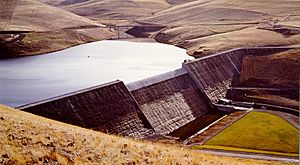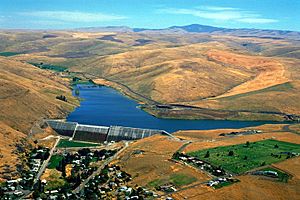Willow Creek Dam (Oregon) facts for kids
Quick facts for kids Willow Creek Dam |
|
|---|---|

Willow Creek Dam and Willow Creek Lake
|
|
| Location | Morrow County, Oregon, U.S. |
| Coordinates | 45°20′49″N 119°32′41″W / 45.34695°N 119.54463°W |
| Construction began | 1979 |
| Opening date | 1983 |
| Construction cost | $37,231,332 (as of June 18, 1997) |
| Operator(s) | U.S. Army Corps of Engineers |
| Dam and spillways | |
| Impounds | Willow Creek |
| Height | 160 feet (49 m) |
| Reservoir | |
| Creates | Willow Creek Lake |
| Total capacity | gross 13,250 acre-feet (16,340,000 m3) usable 9,765 acre-feet (12,045,000 m3) |
| Catchment area | 96 square miles (250 km2) |
| Surface area | 126 acres (51 ha) max 95 acres (38 ha) min |
The Willow Creek Dam is a special dam located in Morrow County, Oregon, USA. It sits just east of the city of Heppner. This dam was the first major dam in the United States built using a new method called roller-compacted concrete. This type of concrete is placed in layers and then compacted, making construction faster and often cheaper.
The dam collects water from a large area of about 96 square miles (249 square kilometers). This area includes dry, rolling hills and also parts of the Umatilla National Forest. The main job of the dam is to control floods. It also helps with fun activities like recreation, supports fish and wildlife, and can be used for watering farms. The dam holds back the water of Willow Creek to create a lake known as Willow Creek Lake.
The water level in Willow Creek Lake can change. It can be as high as 2,113.5 feet (644.2 meters) and as low as 2,063.0 feet (628.8 meters). This allows the dam to store a useful amount of water, about 9,765 acre-feet.
Contents
Why Was Willow Creek Dam Built?
The Big Flood of 1903
A very serious flood hit Heppner in June 1903. About 250 people, which was a quarter of the town's population, died in this disaster. A sudden, heavy thunderstorm caused a flash flood in Willow Creek. The water rushed through the town at an incredible speed of 36,000 cubic feet per second. This event is remembered as the Heppner Flood of 1903.
After this terrible flood, people realized they needed a way to protect Heppner. Studies for flood control began in 1962. In 1965, the U.S. Congress officially approved a project to build a flood control dam. By 1979, the plan for the dam was updated to focus mainly on flood control. Other uses like irrigation would be considered later.
Building the Dam
New Construction Methods
Engineers started testing the new roller-compacted concrete method in 1972. They built a small model of the dam's spillway (the part that releases water) to study how water would flow and if it would cause problems downstream.
The Army Corps of Engineers built the dam between November 1981 and February 1983. Even though the workers were new to this type of concrete, they finished the dam almost on time. It also cost less than expected, coming in at $35 million instead of $50 million. The project showed that roller-compacted concrete could be a fast and affordable way to build dams. About 330,000 cubic meters (431,600 cubic yards) of concrete were placed in less than five months.
Challenges and Solutions
Soon after the lake started filling, engineers noticed a lot of water leaking through the concrete layers. The lake had to be drained. A $2 million project was started to fix the leaks. Workers drilled holes from the top to the bottom of the dam and injected a special material called grout. This helped reduce the leakage significantly.
Over the years, other problems appeared with the lake water. The water would separate into layers, and the bottom layers would run out of oxygen. This caused a bad smell and could even create chemicals that might harm the concrete. People worried about this, and in 2004, a special aeration plant was installed. This plant helps add oxygen to the water, solving the problem. In 2009, devices called SolarBees were also added to help circulate the water in the lake.
Despite these challenges, the Willow Creek Dam was recognized for its innovative construction. It won an award from the American Society of Civil Engineers (ASCE) in 1985.


